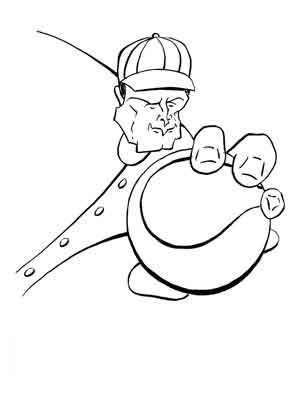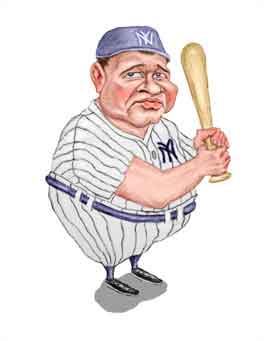Rube Waddell

Rube Waddell
Nutball of the Deadball Era
"Say, did you ever hear of Rube Waddell?"
"Sure, I got an autographed ball from him."
"Don't goof me. You're too young to have got it."
"Well, he gave it to my uncle for me when he was playing in the American Assocation. I got it at home. He was the greatest left-hander in the game, and I know Stuffy McInnis, the greatest first baseman in the game. He gives me balls when the Athletics are here."
Studs said Rube was no good. Danny didn't have any right to have a ball from Rube Waddell. Studs walked away sore.
- James T. Farrell (The Young Manhood of Studs Lonigan)
Whether George Edward "Rube" Waddell really was the greatest left-hander in the game is, as are all "who-is-the-greatest" questions, a matter of opinion rather than actual statistics. But he certainly wasn't bad. Rube's win-loss ratio of 0.574 may not seem all that high - somewhat more than 50 % - but it is still one up from Catfish Hunter and two ahead of Steve Carlton. His very respectable earned run average of 2.16 still stands today as #11 overall and #1 for left handers. Also in one his best years, he ranked #8 in home runs. He hit five.
Of course, the last statistic is the giveaway. Rube played in the so-called "dead-ball era". His professional major league start was in 1897, and he played until 1910. His longest tenure was under Connie Mack for the Philadelphia Athletics where he played from 1902 to 1907. In his first year at Philly, Rube became the first major league pitcher to strike out an entire side on just nine pitches. But 1905 was likely Rube's best year and was when he won the pitcher's Triple Crown with most wins (27), most strikeouts (287), and the lowest ERA (1.48). That was also the year he smacked in his five homers.
In the dead ball era, home runs were largely inconsequential for the outcome of a ballgame. In the larger ballparks (where more than 600 yards sometimes separated home plate to outfield fence), triples were more common than homers, and strategy was what counted. You wanted singles and doubles, hits-and-runs, stolen bases, and well-planned bunts. So "smart" hitters like Ty Cobb hated it when big palookas like Babe Ruth became the idols of the young fans and ruined the game. Babe's 29 homers in the 1919 season was a new record, and when he hit 54 the next year the dead ball era was over.
Despite Rube's undoubted ability it was his antics on and off the field as much as his playing that brought people out to see him. His behavior was so far - pardon a bad pun - off base, that today a topic among baseball experts is what exactly was "wrong" with Rube. The diagnoses ranges from simple immaturity and a puckish sense of humor to "feeble mindedness" as it was called then. Another hypothesis is that Rube drank too much (which he did). Needless to say, in trying to diagnose someone after a century, there is no consensus. And of course, none of the possibilities mentioned are mutually exclusive.

Babe Ruth
The Big Palooka
That Rube suffered from some diminished mental capacity had been hypothesized from the tales of how the opposing fans would distract him by holding up puppies or shiny toys. An oft told story is that if a fire engine went by during a game he had to be restrained from chasing after the engine. Rube's fascination with fire fighting was real enough, and he would indeed run off to a fire to help out. How effective he was is questionable, and his participation may have been no more than standing around shouting out orders which the real firemen ignored. And there are no reliable reports that Rube actually left the mound to chase a fire engine.
Rube's playing declined after 1905, possibly due to an injury he received while he and a teammate were jokingly fighting over a straw hat. Rube fell and injured his shoulder. He missed the World Series that year where the A's played the New York Giants (and lost). He left Philadelphia in 1907 and played briefly for the St. Louis Browns (now the Baltimore Orioles). He then went to the minor league Minneapolis Millners and played from 1909 to 1911.
Rube was in Kentucky in 1912 when he went to assist in a rescue operation after the Mississippi River flooded. He contracted pneumonia and then later was found to be suffering from tuberculosis. Still he managed to play in 1913 for the Fargo-Moorhead Graingrowers. But he soon checked himself into a sanitarium in San Antonio where Connie Mack helped pay the bills. Rube lived until 1914 and died in San Antonio age 37.
Even today Rube would have been a great pitcher. Or perhaps we should particularly today. Although in his time baseball was a pitcher's game, that was also when no balls were counted as strikes. Rube had the best stuff he had ever seen, Connie Mack maintained, and in 1946 Rube was finally and posthumously - and most believe deservedly - inducted into the Baseball Hall of Fame.
References
Although in his time Rube was one of the best known players, it was only within the last few years any biographies appeared. There are two books about Rube which as of this writing are available.
Just a Big Kid: The Life and Times of Rube Waddell, Paul Proia, Publishamerica (2011).
Rube Waddell: The Zany, Brilliant Life of a Strikeout Artist, Alan Howard Levy, McFarland and Company (2000).
As usual you must be careful if you go to the Fount of All Knowledge for information. However, Rube's statistics can be found and there is a good website devoted to Rube.
Baseball Reference: Rube Waddell, http://www.baseball-reference.com/players/w/wadderu01.shtml. Covers Rube's career both in the majors and the minors.
Rube Wadell, Dan O'Brien, http://rubewaddell.net/ The best source for on-line information about Rube. The author has written a screenplay about Rube and has researched his life to help separate out the myth chaff from the wheat facts.